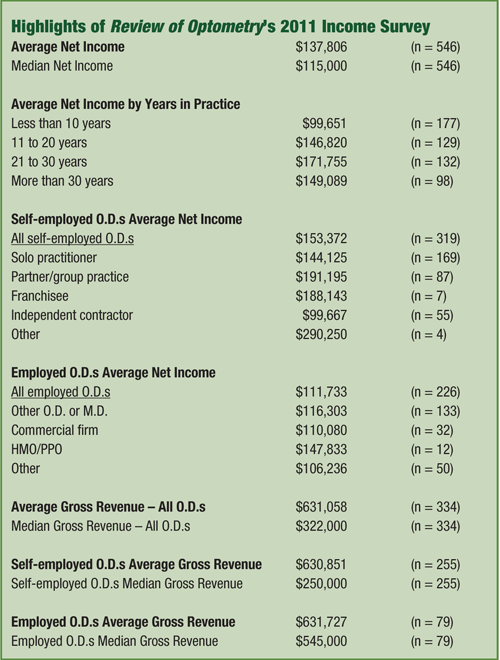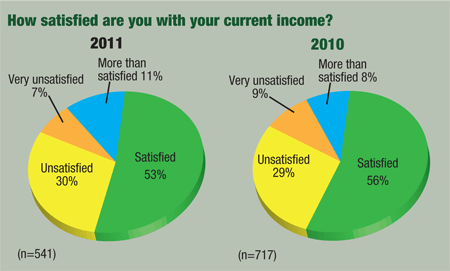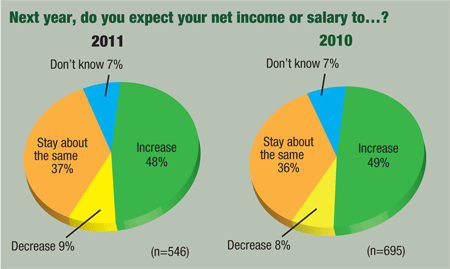 If you haven’t seen the writing on the wall just yet, here it is in black-and-white: Get into group practice. Yes, you can still survive in solo practice (and many do), but you’re more likely to thrive in a group.
If you haven’t seen the writing on the wall just yet, here it is in black-and-white: Get into group practice. Yes, you can still survive in solo practice (and many do), but you’re more likely to thrive in a group.
Look at it this way: A solo practitioner is a sitting duck. You need to get with a flock if you want to fly.
Numbers don’t lie. According to our latest optometric income survey, annual income for solo docs averaged $144,125 last year. But O.D.s in partnership or group practice averaged $191,195—a difference of nearly 33%.
Like other doctors, optometrists are under an ever-growing pressure to invest more in technological and practice costs; group practices can share these expenses and take advantage of efficiencies of scale. That can translate to more profit.
The same transformation is happening in other health care practices—perhaps to an even greater extent among your M.D. colleagues. For example, a recent survey found that when hospitals undertake a search for employment assignments, they hardly even look at solo practitioners.
“Nobody wants to be Marcus Welby anymore, practicing alone or with a partner, and fewer hospitals are seeking solo doctors for their communities,” says James Merritt, founder of Merritt Hawkins, a physician search firm that undertook the study. “To incorporate required technology, comply with regulations, and participate in new delivery models like accountable care organizations, physicians today almost have to be part of larger practices or be employed by hospitals.”
Incentives for quality of care rather than quantity of care are just starting to have an effect on the practitioner’s earnings. “But increasing the volume of services they provide [still] remains the most practical way for physicians to increase their incomes,” Mr. Merritt says.
These are highlights from Review of Optometry’s annual Income Survey. The survey was emailed to more than 30,000 of our readers. More than 8,500 viewed the email, and 685 optometrists responded.
Change in Income
Annual income for all optometrists (including both employed and self-employed O.D.s) averaged $137,806 in 2011, according to our survey.
Take note that we’ve changed our methodology with this survey. In prior years, we had asked you to report your net income, which is income after taxes are taken out. Now, to make our survey easier to fill out and more comparable with other compensation surveys, we ask for your income before taxes. For instance, last year we reported that the average O.D.’s net income was $121,182 in 2010—but that’s after Uncle Sam took his share.
In any event, this means that we cannot provide accurate data about how much optometric income has changed from 2010 to 2011.
Satisfied with Salary
But we can tell you that optometrists’ satisfaction with their income has stayed mostly positive. Whether or not they’re actually making more, most optometrists are pretty happy with the bacon they’re bringing home. That’s a good indicator that optometric income hasn’t declined, at least.

Salary satisfaction was nearly at an all-time low during the depth of the recession in 2009. Only half of respondents (51%) said they were “satisfied” with their 2009 income, and just 6% said they were “more than satisfied.” Another 35% said they were “unsatisfied” and 9% said they were “very unsatisfied.”
But things bounced back in 2010, and have held steady for 2011. This year’s survey finds that as many as 64% of respondents say they were either “satisfied” (53%) or “more than satisfied” (11%) with their current income.
“I make enough to put food on the table, a roof over my head and pay my bills. My family is not in need of any basic essentials,” says Penny Gamez, O.D., of Cedar Hill, Texas. “I also make enough to be able to donate to my church, my community and my children’s school. I feel truly blessed.”
On the other hand, nearly 30% of O.D.s say they’re still “unsatisfied” with their current incomes. However, the number of those who are “very unsatisfied” has decreased from 9% two years ago to less than 7% this year.
In several parts of this country, the depressed economy has yet to bounce back at all—and O.D.s in those areas are still feeling the pinch. “The last few years have really taken a toll on my business and family,” says Gregory Fowler, O.D., of Augusta, Ga. “It has been a year since we have made a mortgage payment on our house. Fewer and fewer people are getting their eyes checked. I am hoping to remedy the situation by moving my practice to a new Costco. I remain optimistic [even though] we could lose our home any day now.”
Salary Specifics
While income for the average optometrist was $137,806 in 2011, we don’t consider any optometrist to be “average.” So, we break it down by mode of employment to give you a more accurate assessment of optometric income.
For instance, O.D.s who are self-employed (whether in solo practice, partnership, group practice, franchises or independent contractors) had an average salary of $153,372.
Billy Andrews, O.D., of Horse Cave, Ky., is one of those successful self-employed solo practitioners who doesn’t need a flock to fly. “I have a practice that nets 44%, compared to the average practice that nets 30%. I accept no vision plans. I accept Medicare, Medicaid and major medical insurance. I practice 35 hours per week and take eight to 10 weeks of vacation per year,” he says. “This is all accomplished in a 2,000-square-foot office with myself and three employees, [located] in a rural area where over 20% of the population falls below the poverty level.”
For optometrists who are employed (by another optometrist or M.D., a corporate firm, an HMO or PPO, or in other employment) average salary was $111,733 in 2011.
“Considering the state of the economy, I feel fortunate to be employed and making what I do,” says one optometrist in a commercial practice in Iowa.
But not every employed optometrist is as satisfied. “I make my employers a lot of money, but they do not believe in ‘trickle down economics’!” says one O.D. who asked to remain anonymous.


(For average incomes in specific optometric settings, see “Highlights of Review of Optometry’s 2011 Income Survey.")
As you might predict, highly experienced doctors have a greater income than younger docs or senior docs nearing retirement. Specifically, O.D.s who’ve been in practice 21 to 30 years average the most: $171,755. Those with 11 to 20 years under their belt average $146,820, and those with more than 30 years (a number of whom are in semi-retirement) average $149,089. Optometrists with less than 10 years of experience earn an average of $99,651.
“At this point, I’m just happy that I’m able to pay the bills,” says one of these younger docs, Scott Baylard, O.D., whose solo practice in Cumming, Ga., is still relatively new.
Bear in mind that very high or very low individual salaries may skew the results in surveys such as this one. So, median income—the midpoint of all responses—may provide a better snapshot of the typical O.D.’s income. Median income for all optometrists was $115,000 in 2011. For self-employed O.D.s, it was $129,000, and $105,000 for employed O.D.s.
‘Doing Things Better’
Expenses are going up, reimbursements are going down, and revenues from goods and services have remained flat. So it’s no surprise that profit margins are not rising.
Profit margin is calculated as net income divided by gross revenue, and it’s commonly used to indicate a company’s economic health. According to our surveys, profit margins have been about the same since 2008. The numbers for 2011 are almost identical to those of 2010: More than half of optometrists (57%) say that their profit margin hasn’t changed. At the same time, 22% of respondents say their net in 2011 did increase as a percentage of gross, while the same percentage (22%) say it decreased.
To make a profit when faced with reduced revenue, businesses have tightened their belts on spending. But you can only tighten your belt so far. “We are doing things better regarding running the business,” says Scott Tomasino, O.D., of his partnership practice in O’Fallon, Mo. “But our reimbursements continue to decrease from insurance, and this makes up a significant percentage of our revenue.”
Noses to the Grindstone
Optometrists are working as hard as ever—and perhaps just a little bit more than before. Optometrists’ average work-week in 2011 was 39.4 hours, which is up just a bit from 39.2 hours a week in 2010. This reverses a slight downward trend in work hours during the past few years.
Self-employed optometrists continue to put in more time than their employed colleagues, but perhaps that gap is closing. Self-employed docs averaged 39.5 hours per week while employed O.D.s worked 39.3 hours on average. (These numbers reflect a total of patient hours and administrative time for all O.D.s.)
Since opening up solo six years ago, “I now work fewer hours and make more than I did as an employee,” says Karen Merkle, O.D., of her Milwaukee practice. “I just wish that I could actually take out the profits that I have been taxed on. Unfortunately, it is cash needed to fund the business.”
Plans for the Future
Optometrists are fairly optimistic about a brighter tomorrow. Nearly half (48%) expect their income to increase in 2012, while 37% hope it will at least remain the same. Only 9% foresee a decrease in their income.
Perhaps this optimism mirrors the current Consumer Confidence Index, which increased nine points in September—the highest it’s been since February this year. “Consumers [are] more positive in their assessment of current conditions, in particular the job market, and considerably more optimistic about the short-term outlook for business conditions, employment and their financial situation,” says Lynn Franco, director of economic indicators at The Conference Board. “Despite continuing economic uncertainty, consumers are slightly more optimistic than they have been in several months.”
But optimism is only a forecast. It’s hard work that turns dreams into reality. To that end, our readers have a number of practical plans to improve their lives and livelihoods:
- “We are going to expand and bring in another O.D., plus increase our [vision therapy] department,” says Jerry Larsen, O.D., of Casper, Wyo.
- “We will be adding an OCT and billing for glaucoma treatment for the first time,” says Greg Pearl, O.D., of his Norwalk, Calif., practice.
- “More medical office visits,” says Wesley A. Rainwater, O.D., of Tulsa, Okla.
- Dr. Tomasino says, “We are planning to move to a bigger space to improve efficiencies and allow us to see more people.”
- “We are advertising more and doing a direct mail piece with a local chiropractor,” says Jean Templin, O.D., of Myerstown, Pa.
- Kristie Homuth, O.D., of Montclair, Calif., says she plans to “contract an outside consultant to establish a training program to train staff to handle phone inquiries better [and] convert callers into scheduled patients.”
- Chris Huston, O.D., of Pella, Iowa, has a simple but solid plan: “Continue to provide excellent service to my patients to grow my practice.”

